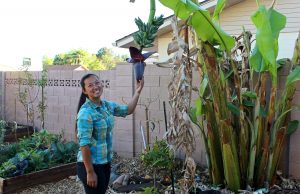A good place to start weather you are starting from scratch or developing your garden year by year is to gain wisdom from all you can observe of your landscape. Doing this will minimize gardening pitfalls. Look out your window, walk around your garden area.
Collect all the information you can to gain understanding of what and when things should be done. Common sense goes a long ways, add that with your personal observations, and you have all you need to get a good start the best usage of your time to gain the most results.
Step back and look closely at how the landscape is performing, both functionally as well as aesthetically. Ask these questions: What goals do I have? Do I want a dual purpose garden? Will it provide mental respite as well as healthy crops? What features lend themselves to a focal point (dominant feature) or pleasant walkway for planning around? How do pole beans or upright sweet corn set the stage? How do the oregano and mint textures (leaf and stem) harmonize with the colors, silhouettes and shapes of their companion plants? What type of lighting and shadows from the sun at various stages of the day as well as the evening moon’s rays do you see to add to the excitement of the view? These are just a few considerations that may bring greater enjoyment to that bell pepper’s flavor or the pie grandma made from your rhubarb, or mint in your glass of ice tea, or maybe a fruit salad with hand-picked blueberries and strawberries.
Mark, stake, label, or flag to indicate the exact locations of seeds, vining plants, watering and fertilizing sites are. As your squash vines start sprawling over this will help you not get lost as to where the hose end went.
If you started your tomato plants indoors or purchased them, you will want to transplant them one inch or deeper (to the first set of leaves). Put stakes or cages up now so you don’t have to hassle with it later and risking damage to your plant.

Sweet potatoes are good to plant this month in the Midwest. Replace cold season plants with warm season varieties such as beans, egg-plant, and pepper. Work up the space, add some organic matter then plant after last harvest of your cold season vegetables. Keep proper spacing for sweet or pop corn to ensure proper cross –pollination and room for mature growth.
Shad from direct sunlight allows for a longer harvest time. Cool season leafy vegetables like lettuce, spinach and others will benefit from a shade cloth or fabric with the density of window screen over them.
After you cut and enjoy asparagus spears (not beyond stalks reaching pencil sized), allow the plant to grow and fern out (opening of leaves). Thin out and remove plant seedlings of beans, anise, and peas from any situation to avoid overcrowding. Select, if possible, the weakest plants to discard. New growth, tie up on vines as they need to avoid breaking stems and damage.
Watering good yet do so responsibly:
Keep as much moisture off the plant leaves, therefore minimize overhead watering. To continue watering from over head increases the chance of disease. If you must water from overhead, do it as early in the morning as you can so the leaves may dry during the day.
Grapes need a balance of (12-12-12 or similar) fertilizer. One quarter cup around each vine installed earlier this year. Apply fertilizer to older vies as the bulbs swell. Use one cup for two-year-old vines. One to One-one half cups for three-year-old vines and one to two cups of plant food for each year of growth on older vines.
Tomatoes need tomato fertilizer with an analysis 6-24-24 or similar product.
The first number is low so minimize adding nitrogen. Nitrogen encourages foliage and minimized fruit formation.
For your apple trees you will need to fertilize the ones which have been in place one year or longer. Administer one pound of 12-12-12 each year.
To save the energy of the rhubarb plant, cut off flower and seed stalks. Flowers from any squash and any fruits at the time of installation pinch off (remove). The plant will spend its energy trying to develop and keep fruit growing but it needs time to acclimate and establish in the garden.
Watch for asparagus beetles and striped and spotted cucumber beetles. These pests chew and transmit diseases in specific plants. Apple trees signs to watch for are codling moths; the caterpillars are leaf eaters.
Caterpillars start showing up on many crops this month, especially cabbages and broccoli. Inspect leaves for chewing, remove or apply a safe chemical control directly on the caterpillar. You could use Bacillus (Bt) biological spray per package directions.

Several insects that disrupt fruiting will visit your grapes; control them with insecticidal soap to lessen the impact.
Grape foliage with blackened or gray film on it will need to be thinned out so air movement can be increased through the plant. Check the base of grapevines after a severe winter for unusual looking growth. Cut vines to ground. Retrain the new growth onto the arbor or trellis. If the leaves appear pale or stunted, the nutrient level may be unbalanced or inadequate. Take a soil sample to your local garden center if you are unsure.
Blueberry bushes with a yellowing discoloration on the leaves are a sign of iron deficiency or unavailable nutrients. Iron sulfate at the label rate of application can be used to begin the recovery process. This may take a few seasons.
An insect identification guide with color pictures can greatly help identify unknown infestation problems. You can purchase these at local garden centers or nurseries.
 Burke Knows Words A vision for your life
Burke Knows Words A vision for your life